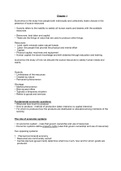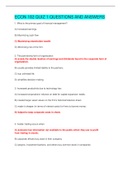Econ 102 (ECON 102)
Pennsylvania State University - All Campuses
Page 4 out of 49 results
Sort by
the chapter 1 notes for econ 102 gives a brief knowledge about economics and types of economy and their working in the society
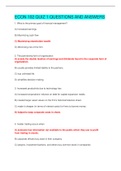
-
ECON 102 QUIZ 1 QUESTIONS AND ANSWERS
- Exam (elaborations) • 9 pages • 2022
-
- $9.49
- + learn more
ECON 102 QUIZ 1 QUESTIONS AND ANSWERS 1. What is the primary goal of financial management? A) Increased earnings B) Maximizing cash flow C) Maximizing shareholder wealth D) Minimizing risk of the firm 2. The partnership form of organization A) avoids the double taxation of earnings and dividends found in the corporate form of organization. B) usually provides limited liability to the partners. C) has unlimited life. D) simplifies decision making. 3. Increased productivity ...
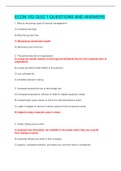
-
ECON 102 QUIZ 1 QUESTIONS AND ANSWERS
- Exam (elaborations) • 9 pages • 2022
-
- $9.00
- + learn more
ECON 102 QUIZ 1 QUESTIONS AND ANSWERS 1. What is the primary goal of financial management? A) Increased earnings B) Maximizing cash flow C) Maximizing shareholder wealth D) Minimizing risk of the firm 2. The partnership form of organization A) avoids the double taxation of earnings and dividends found in the corporate form of organization. B) usually provides limited liability to the partners. C) has unlimited life. D) simplifies decision making. 3. Increased productivity ...
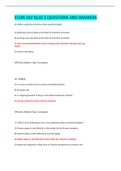
-
ECON 102 QUIZ 2 QUESTIONS AND ANSWERS
- Exam (elaborations) • 13 pages • 2022
-
- $10.77
- + learn more
ECON 102 QUIZ 2 QUESTIONS AND ANSWERS 25. When using the economic order quantity model A) ordering costs increase as the level of inventory increases. B) carrying costs decrease as the level of inventory increases. C) costs are minimized when total carrying costs and total ordering costs are equal. D) none of the above Difficulty: Medium Type: Conceptual 26. Hedging A) is a way to protect your accounts receivable position. B) increases risk. C) is a legal agreement to buy or sell a financial fu...
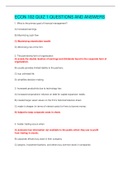
-
ECON 102 QUIZ 1 QUESTIONS AND ANSWERS
- Exam (elaborations) • 9 pages • 2022
-
- $8.98
- + learn more
ECON 102 QUIZ 1 QUESTIONS AND ANSWERS 1. What is the primary goal of financial management? A) Increased earnings B) Maximizing cash flow C) Maximizing shareholder wealth D) Minimizing risk of the firm 2.
ECON 102 QUIZ 1 QUESTIONS AND ANSWERS 1. What is the primary goal of financial management? A) Increased earnings B) Maximizing cash flow C) Maximizing shareholder wealth D) Minimizing risk of the firm
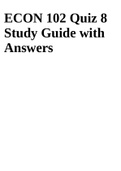
-
ECON 102 Quiz 8 Study Guide with Answers
- Exam (elaborations) • 5 pages • 2021
- Available in package deal
-
- $5.99
- + learn more
ECON 102 Quiz 8 Study Guide with Answers 1 ECON 102_Quiz 8_Study Guide with Answers A monopolist faces a demand curve given by: P = 210 – 5Q, where P is the price of the good and Q is the quantity demanded. The marginal cost of production is constant and is equal to $60. There are no fixed costs of production. How much output should the monopolist produce in order to maximize profit? None of these. The monopolist should produce the quantity where Marginal Revenue equals Marginal Cost. ...
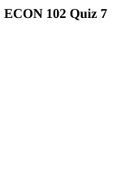
-
ECON 102 Quiz 7
- Exam (elaborations) • 4 pages • 2021
- Available in package deal
-
- $5.49
- + learn more
1. Which of the following is an assumption that underlies the perfectly competitive model? A. There are barriers to entry B. All firms sell differentiated products C. All firms are price setters D. There are many firms *** In a perfectly competitive model, there are many firms that sell homogeneous products. Firms are price takers and there are no barriers to entry. 2. Which of the following statements is correct? A. A perfectly competitive firm faces a perfectly elastic demand curve and...

Study stress? For sellers on Stuvia, these are actually golden times. KA-CHING! Earn from your study resources too and start uploading now. Discover all about earning on Stuvia

